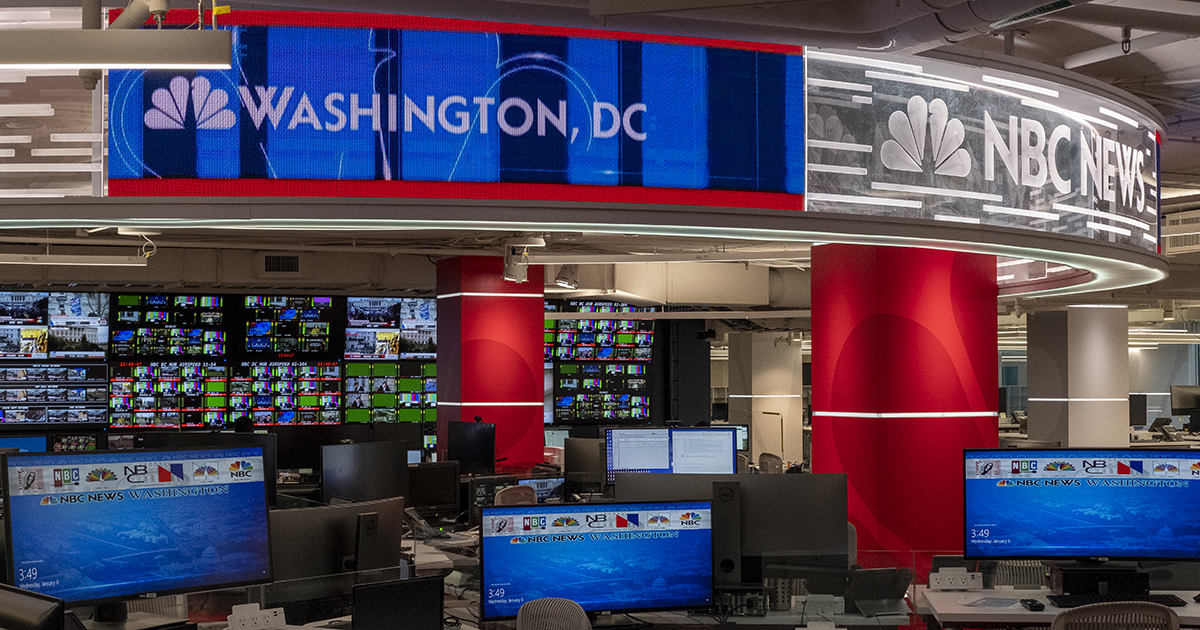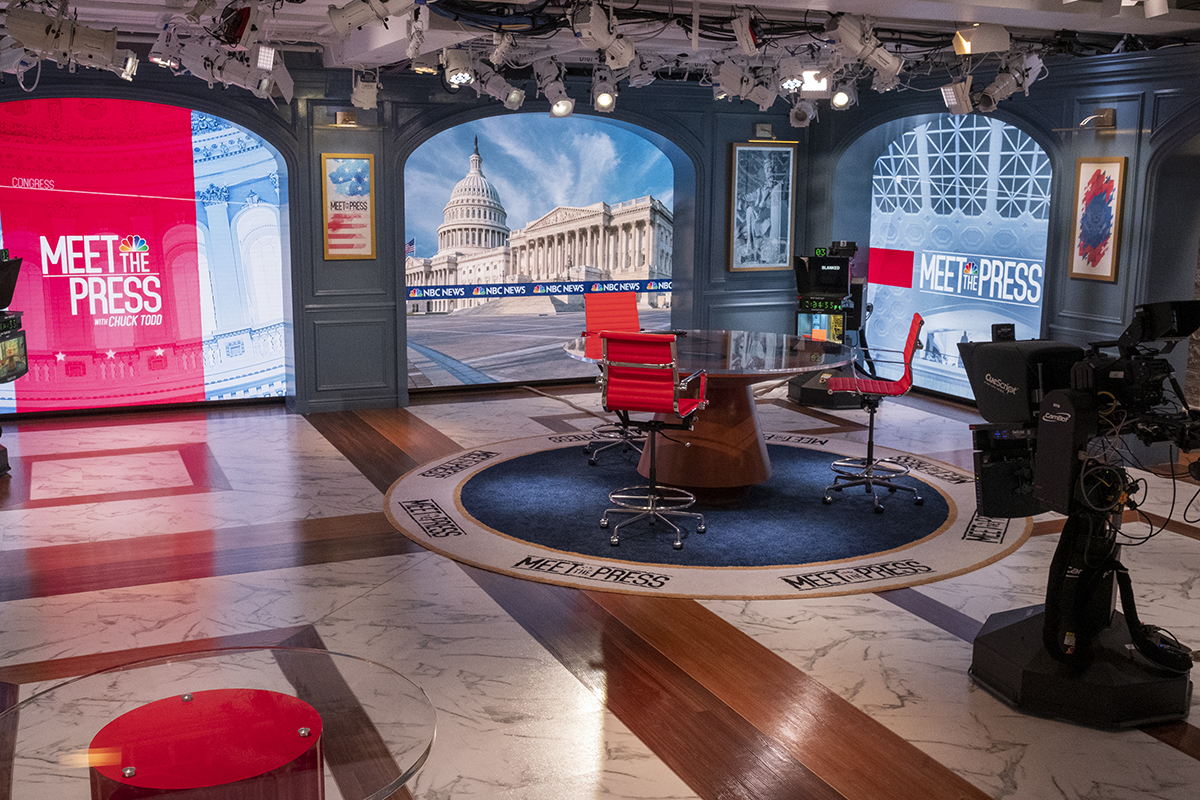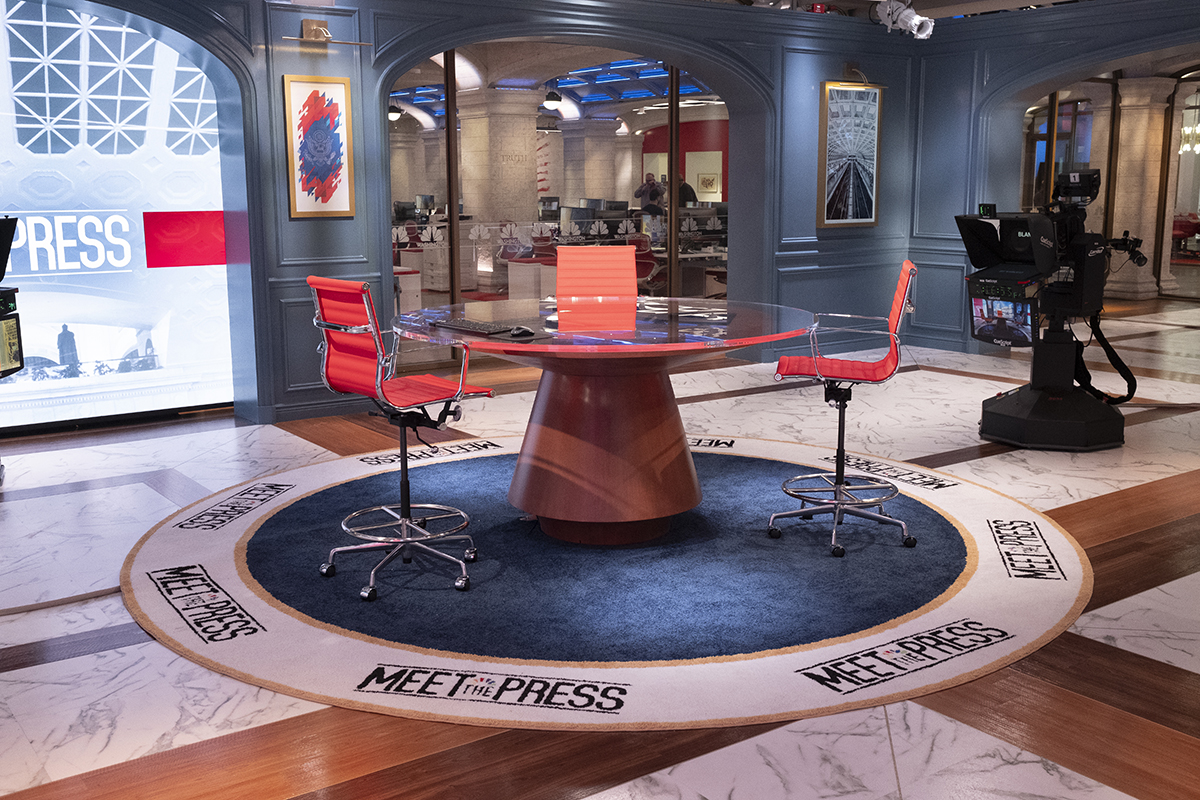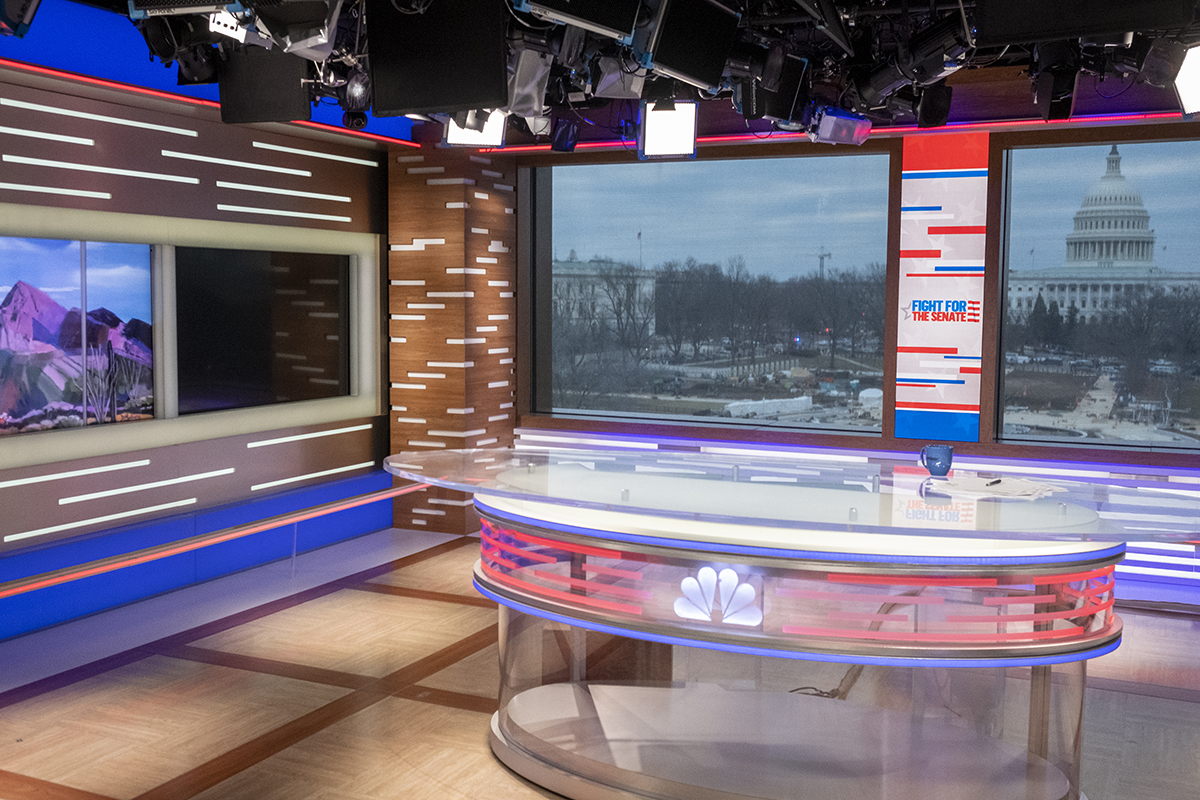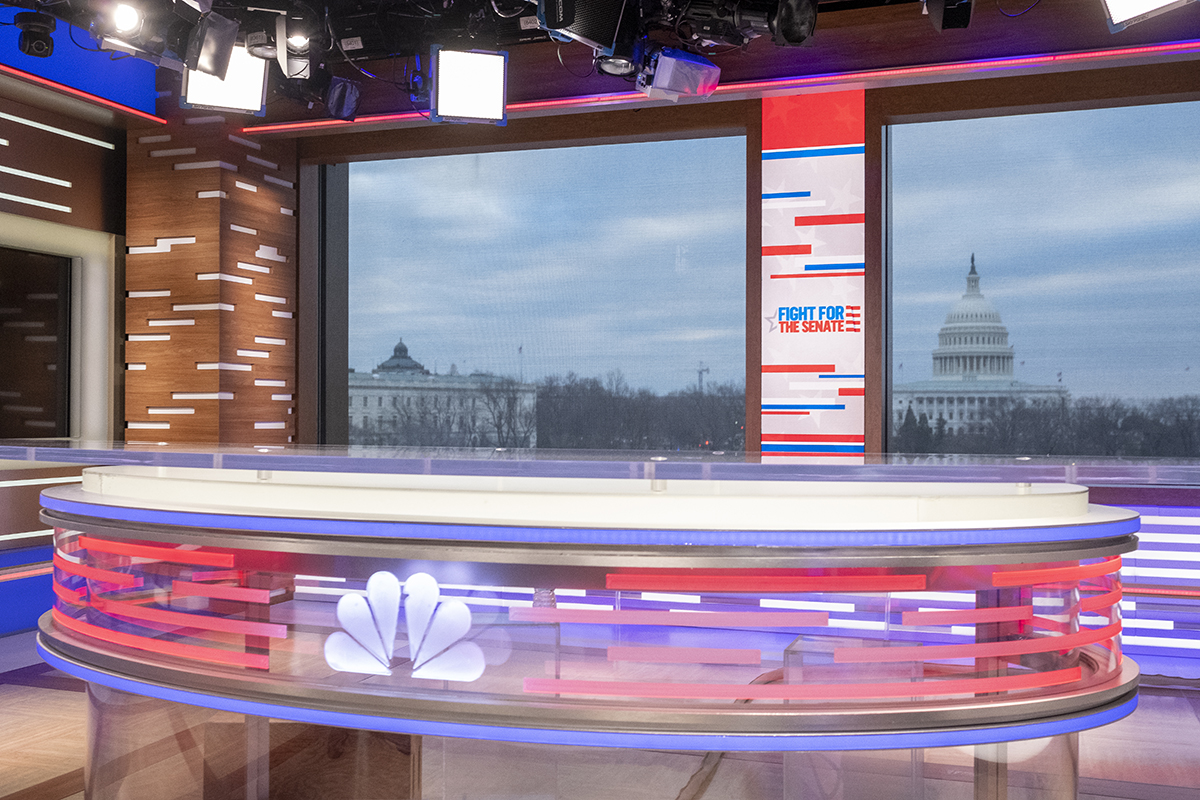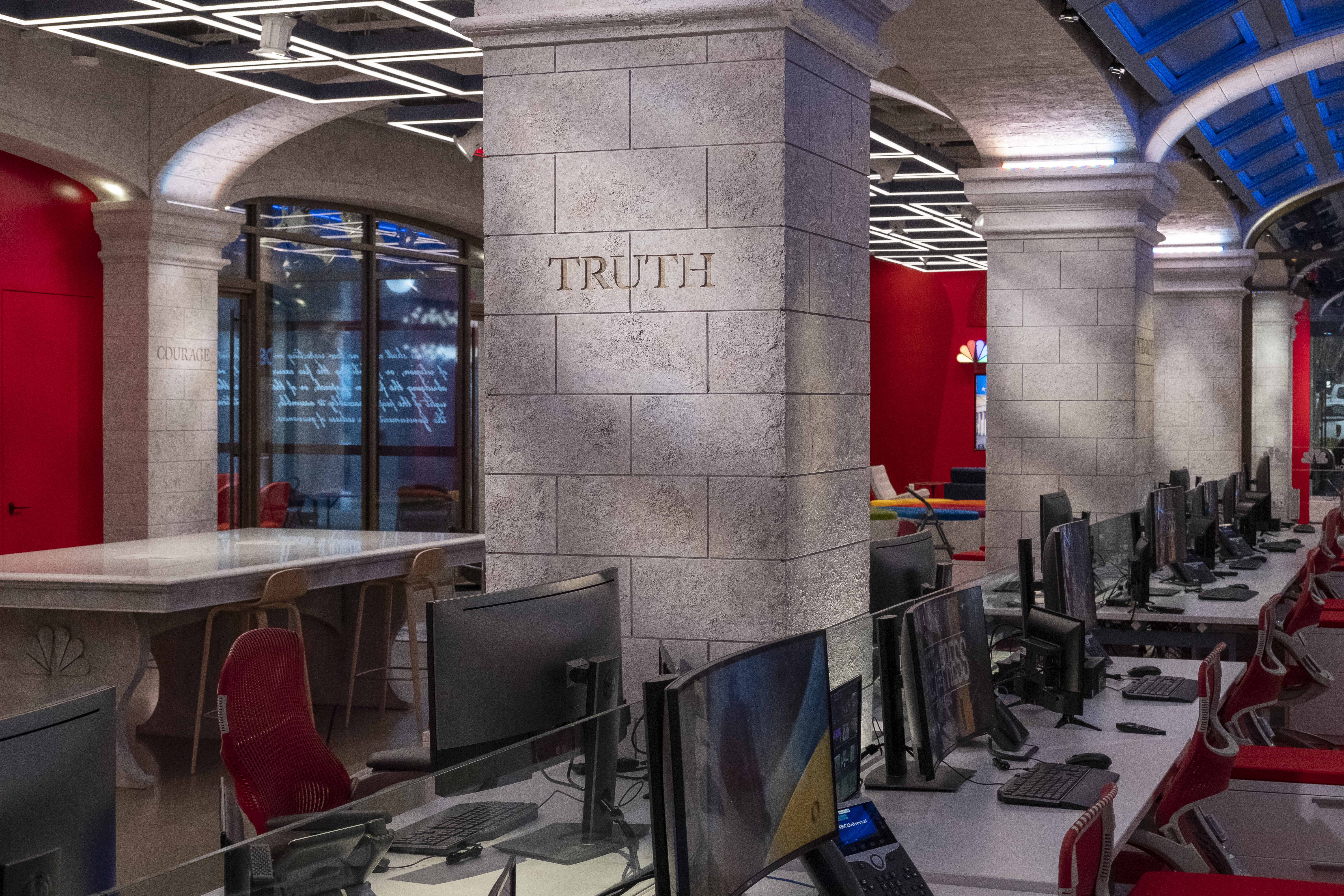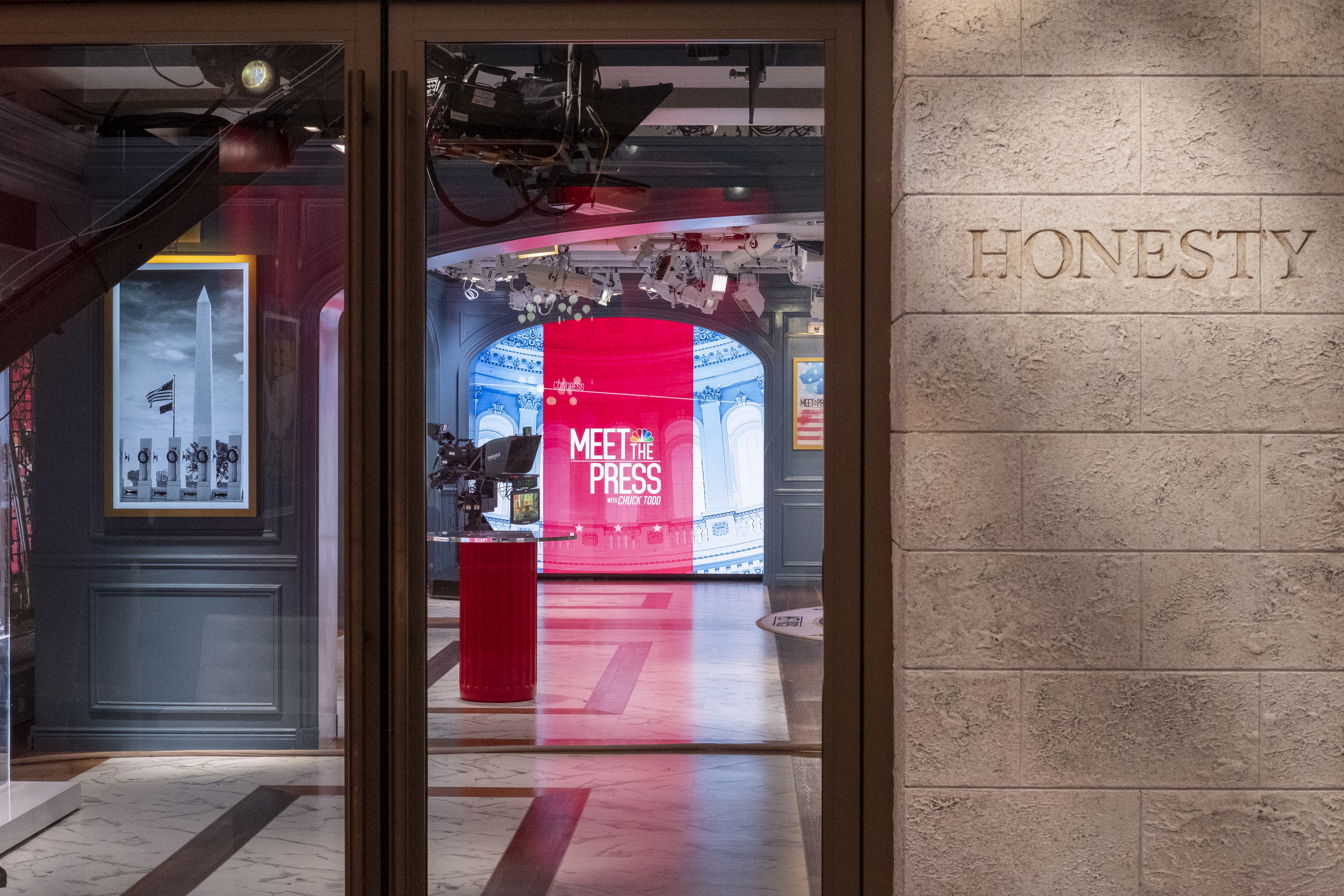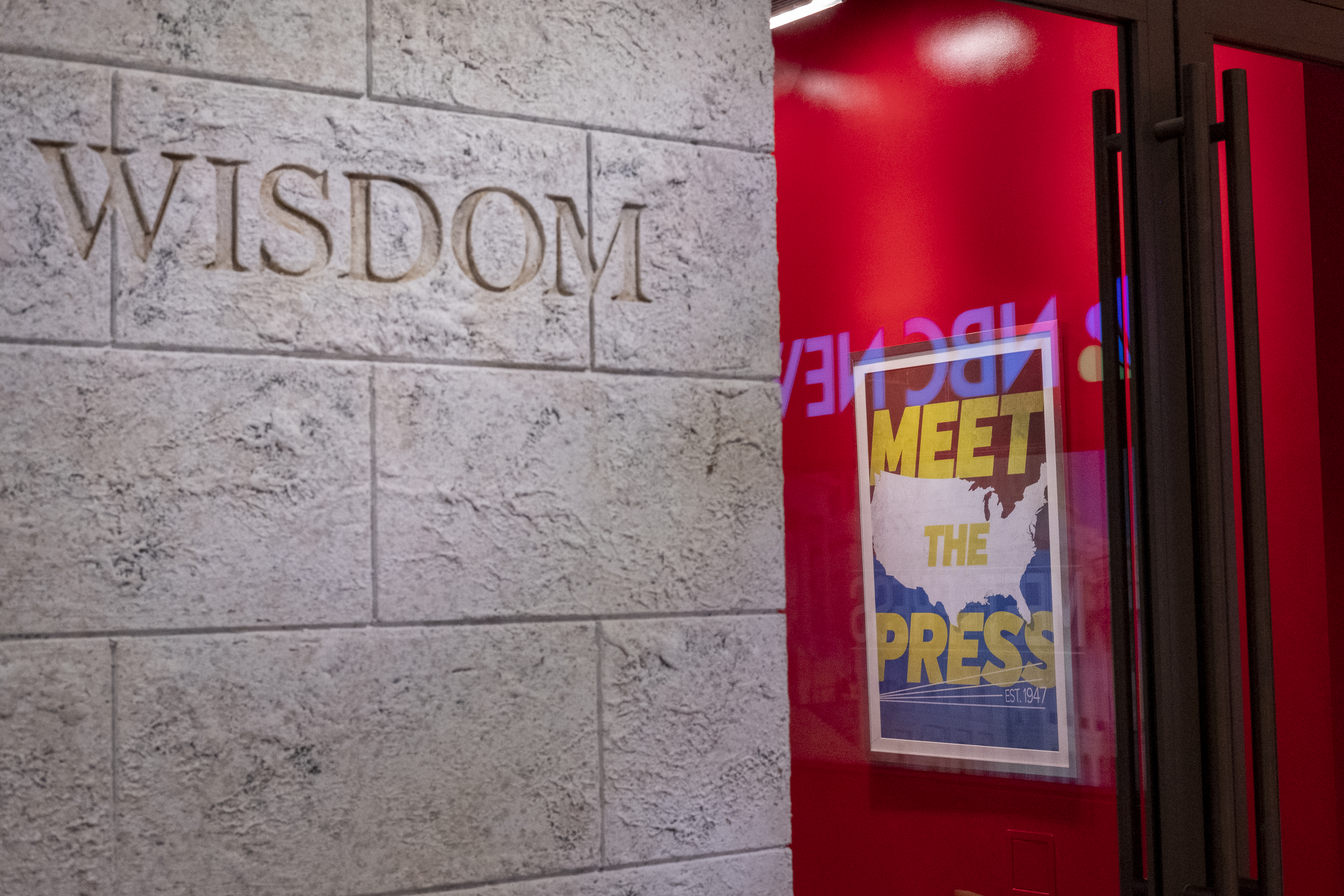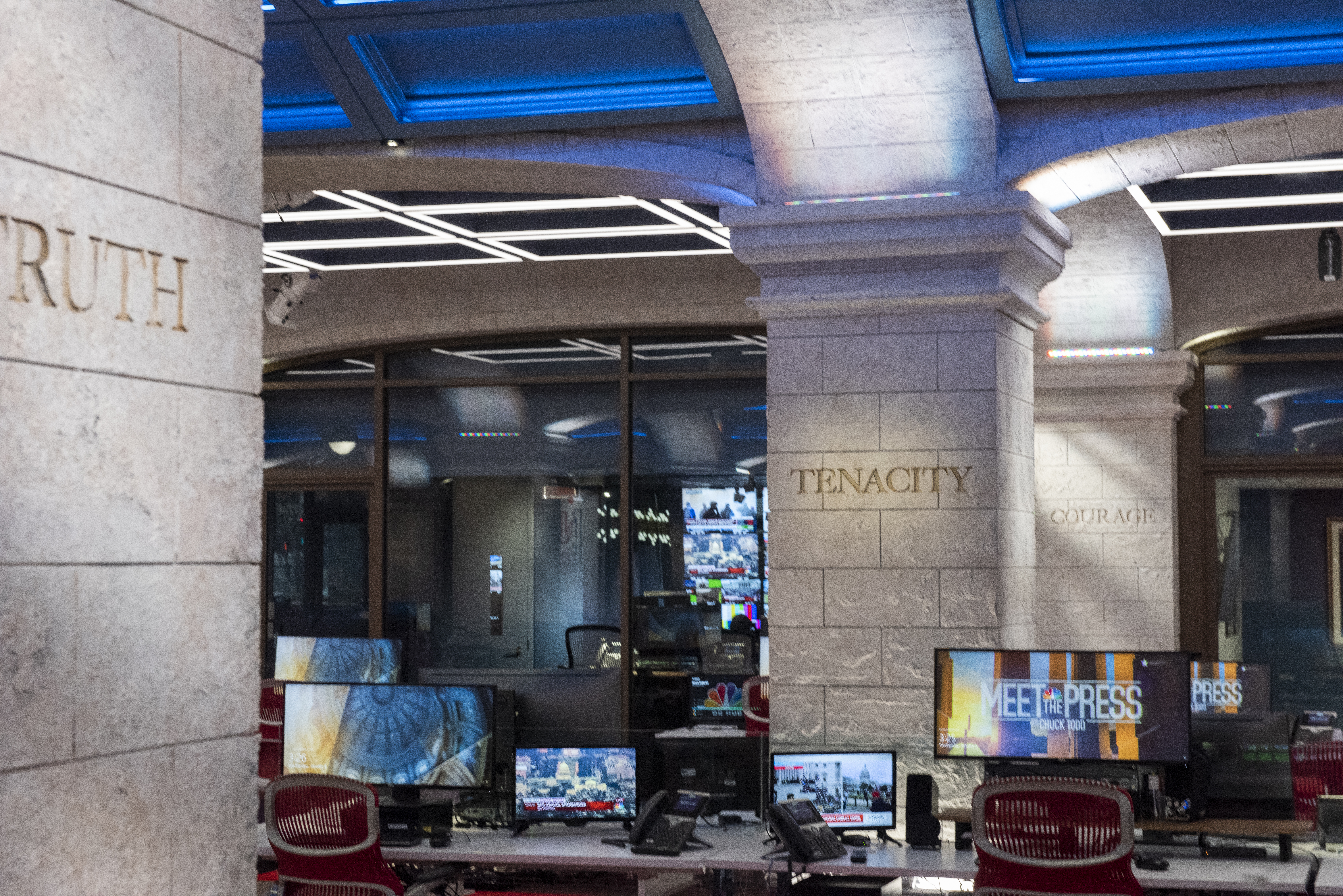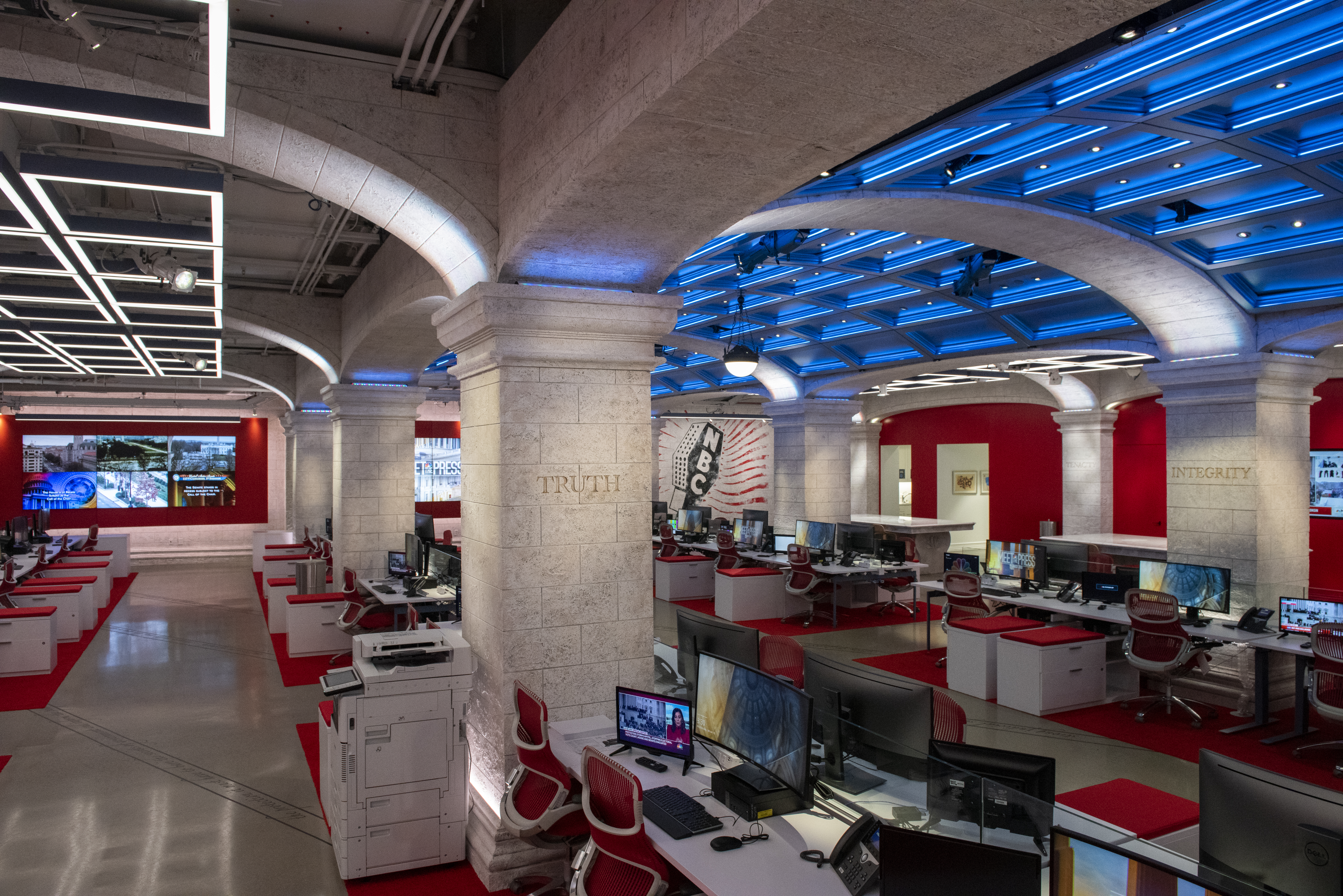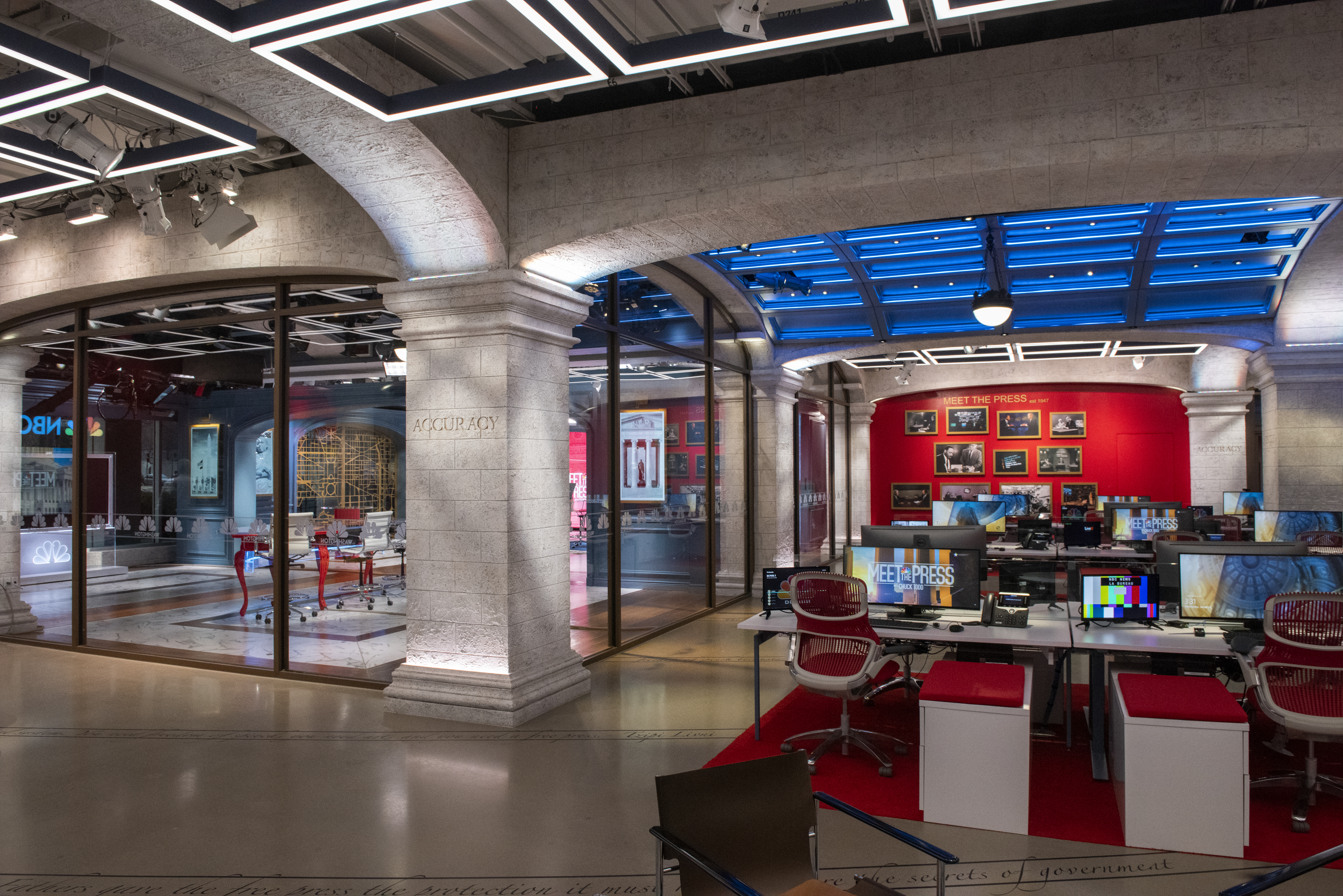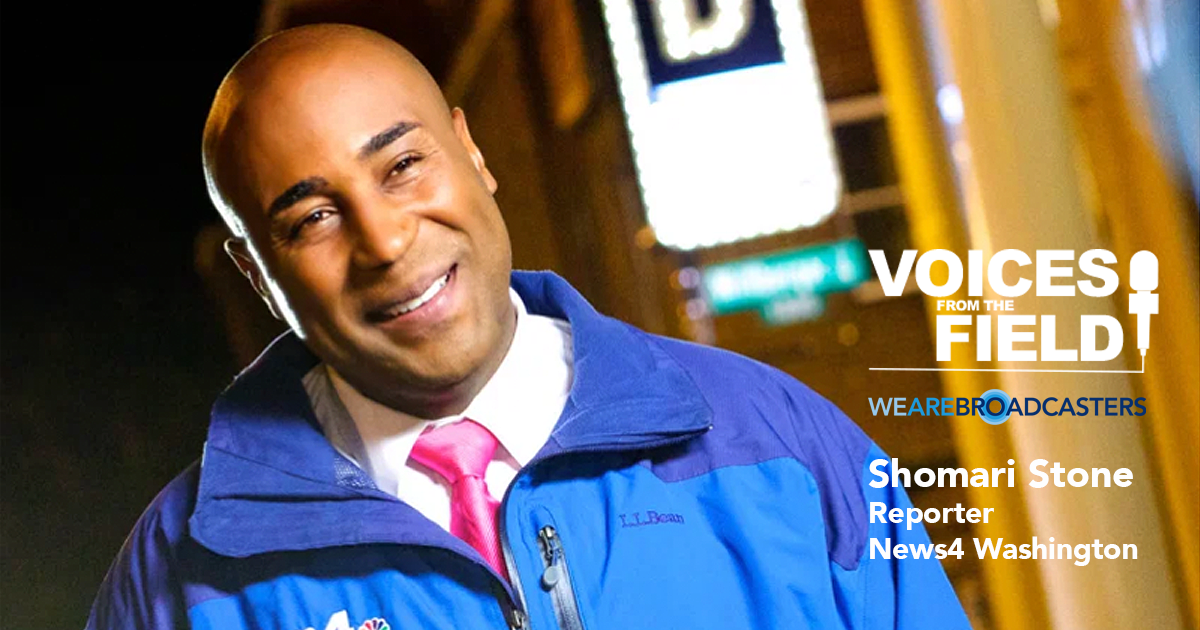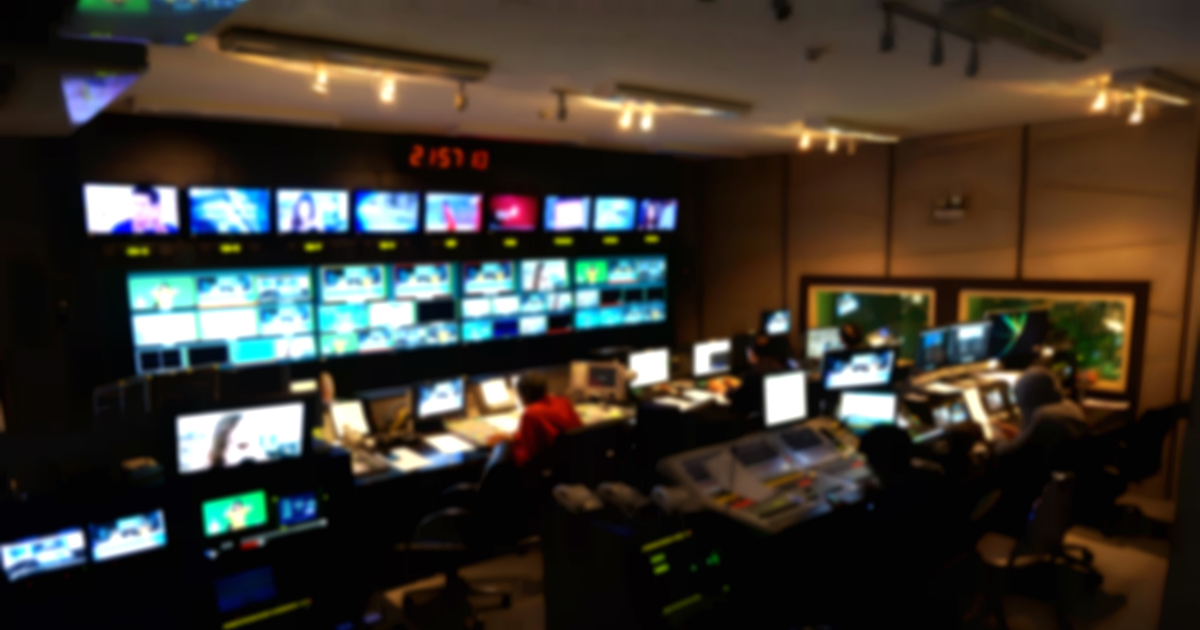In late January NBCU News Group debuted its new studios and expansive Washington Bureau with Meet the Press live from the network’s new D.C. headquarters for the first time.
The new bureau spans six floors and 80,000 square feet, with seven studios for programming across NBCU News Group’s flagship networks: NBC News, MSNBC, and CNBC. Also in the bureau are NBC News Channel, Noticias Telemundo, and Sky News’ Washington operations.
Inspired by the prominent neoclassical and federal-style architecture found throughout the nation’s capital and neighboring Union Station, NBCU News Group’s new Washington bureau boasts 14-foot high ceilings with a coffered ceiling reminiscent of Union Station’s Main Hall. Modern lighting, contemporary finishes, and state-of-the-art technology — including 650 square feet of tracking LED walls — reflect today’s modern newsroom aesthetic and advances in broadcast production.
Ten-foot floor-to-ceiling windows circle the main first-floor studio, similar to Studio 1A at NBC News Headquarters at 30 Rockefeller Plaza in New York, allowing the public to see and experience news production lives and in person. Plus, exterior-facing LED screens showcasing live programming and running news-tickers flank the facade of the building. “Accuracy,” “Courage,” “Freedom,” “Truth” and quotes from former presidents, scholars, and authors all reinforcing the importance of a free press are etched into columns throughout the studio and newsroom spaces.
Nine programs across NBC News and MSNBC are broadcasting from the new bureau in 2021, including the network’s #1 flagship Sunday public affairs program, Meet the Press with Chuck Todd, and Weekend TODAY with Peter Alexander and Kristen Welker on NBC News. Plus, programming across MSNBC primetime, dayside, mornings, and weekends originate from there, including The ReidOut with Joy Reid, MTP Daily, Andrea Mitchell Reports, MSNBC Live with Hallie Jackson, Way Too Early with Kasie Hunt, The Cross Connection with Tiffany Cross and The Sunday Show with Jonathan Capehart.
The bureau also serves as a home base for special programming for TODAY, NBC Nightly News with Lester Holt, NBC News Special Reports, and MSNBC special coverage for future major Washington events such as inaugurations, State of the Union Addresses, and more.
The studios and modern workspaces are headquarters for more than 400 NBCU News Group employees, including the networks’ White House, Capitol Hill, and political units; the investigative, national security, Pentagon, Justice Department, foreign affairs, and transportation reporting teams; the network’s Washington-based NBC News Digital operations; and producers for TODAY, NBC Nightly News and MSNBC.
The move follows more than 60 years of NBC News broadcasting from the historic 4001 Nebraska Ave. studios where President Eisenhower joined NBC President Robert Sarnoff in 1958 for the formal dedication of the network’s Washington operations.
The famed bureau was the location of the second Nixon-Kennedy debate, the first television appearance of The Muppets, and was home to the longest running program in television history, Meet the Press, for several decades.
Marc Greenstein is the Senior Vice President of Design & Production for NBC News and MSNBC. Ken Strickland is NBC News Vice President and Washington Bureau Chief. Stacy Brady is the Executive Vice President & General Manager of NBC News Field & Production Operations. Matt Cuddy is the CNBC Washington Bureau Chief.
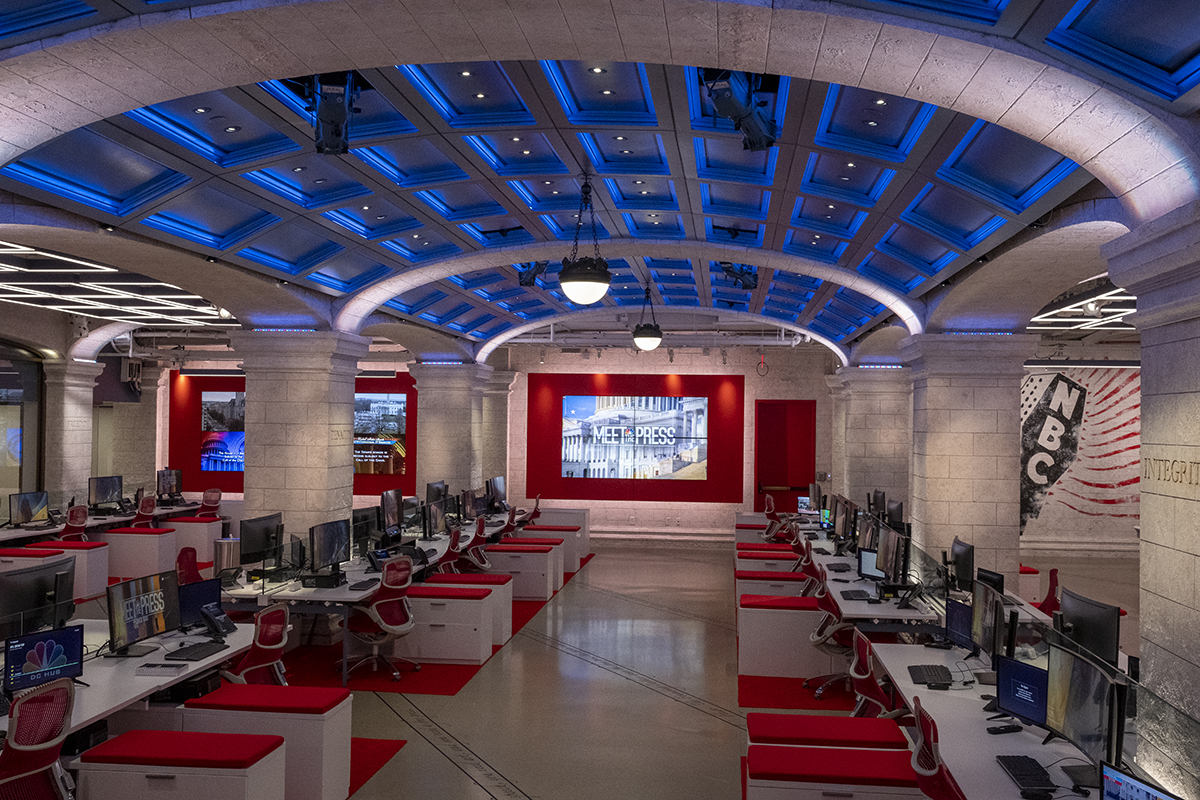
Newsroom and studio designs were by NBC News’ Marc Greenstein and Bryan Higgason of HD Studios. The lighting design was by The Lighting Design Group. Scenic elements were provided by Black Walnut, and technical systems integration was by Beck-TV.
Pandemic Forced a Total Change in All Aspects of Operations
NBC News Chairman Andy Lack originally announced the plan to move to a new headquarters at a town hall meeting in July 2019. “Moving from NBC News’ historic Nebraska Avenue location to North Capitol allows us to brand ourselves in Washington in ways we’ve never done before,” said Lack at that time.
The original timeframe called for the new studio and bureau to be up and running by March 2020, in time for Super Tuesday coverage. Needless to say, the COVID-19 pandemic that swept across the globe in February and March 2020 pushed the timeframe backwards in its wake.
To get a picture of the core technologies and workflows behind the new studio — and to learn also how the pandemic changed the planning process and subsequent approach to live production — NAB Amplify spoke with Jay Hurt, Vice President of Engineering and Operations for NBC News Washington Bureau. We began by asking Hurt what sort of technology backbone was the system design team looking at in 2019, and whether IP/SMPTE2110 was part of the plan at that time.
Jay Hurt: “Yes it was, NBC News wanted to move to a full IP-based router for our core. We choose to go with twin redundant Evertz EXE IP routers to replace our existing Utah 1024 x 1024 router.
“This decision was based on several factors, including future expansion and scalability, flexibility with different formats, ability to handle 4K camera transmissions, and the need to move compressed and uncompressed technology simultaneously.
“Traditional routers were somewhat restrictive. The Evertz IP backbone gave us the total package. A pair of fibers is all that’s needed to connect and manage all the different formats, streams, monitor wall options and distribution copies. It’s all available, with the change of a card, a different backplane, and a programming upgrade.”
How did coronavirus force the team to re-think how the studios and news production operations would physically work?
“The pandemic forced a total change in all aspects of what we were doing. We shut down in-studio operations and moved almost all our anchors and correspondents to home studio setups.
“We cut the number of people coming into the bureau to a bare minimum and set up remote work-from-home technical stations for the bulk of our operations staff. We also changed the protocols for ENG crews and started bringing guests in our productions via Zoom, Teams or other internet transmission options.
“One of the biggest challenges we faced was monitoring all of the raw material as it was coming in and being recorded. We quickly utilized existing encoders to stream content to a cloud-based website we established with Amazon Web Services.
“It worked great as a quick solution but was not feasible for live control room remote monitoring due to signal delays. We had several channels of TMath available for real time feeds and we used these for live programing returns or prompter feeds to folks at home.
“Our team set up several other feed monitor options using inexpensive web encoders, which we embedded in Microsoft Teams to allow our remote users access via home computers. This direct approach cut the delay and gave us unlimited home viewing options.
“We worked with all our vendors and set up remote logins so companies like Evertz could program remotely. We got creative when needed by using video conferencing and cell phone cameras when remote viewing of site condition updates were needed. We were lucky that our core router and tech racks were in our first phase and mostly completed before the pandemic restrictions hit in full force.”
So what was the final ‘backbone’ approach taken, and can you outline some of the key vendors/partners involved in putting that core in place?
“We worked with Evertz for most of the technical backbone. We use Calrec and Dante for audio; RTS for comms; Jetwave for RF; American Systems for fiber and CAT5/CAT6 connections; Vizrt for graphics; Sony and Panasonic for cameras; Sony for production switchers; Ross and Telemectics for robotics; Leyard Planar and Neoti for studio monitor walls, and a whole host of other vendors for ancillary equipment.”
Probably the major ‘story’ to the outside world on the unveiling of the new studios was the stunning architectural approach taken with columns throughout the studio and numbers spaces emblazoned with journalistic touch-point words like “Accuracy”, “Courage”, “Freedom” and “Truth”. But what are some of the technology/operational innovations the team is proud of to match the accolades garnered for the physical appearance of the new studios?
“I think creating the full IP workflow is the biggest jump from a technology standpoint. This advancement allows for so much flexibility in content distribution.
“We also focused on the average workstation to give everyone consistency in work experience. We designed each workstation with enough connectivity to install all the technical tools any user would need.
“With remote connection technology, every computer we deploy can be an edit station, router, and a line producer monitoring station. With enough bandwidth, almost anything can be set up quickly on any desktop.”
“With remote connection technology, every computer we deploy can be an edit station, router, and a line producer monitoring station.”
Beck TV was the technical systems integrator: were they on the ground from start to finish and what would you say about that partnership?
“Beck TV has been a great partner throughout our project. They demonstrated early on that they had a thorough understanding of IP standards and infrastructure having recently installed several large Evertz EXE systems prior to our project. Their experience with overall IP solutions and technology was invaluable as we looked to establish a complete and seamless SMPTE 2110 workflow infrastructure.
Obviously, the move has now been made with 90% of staff working from home due to the pandemic. What are some of the practical ‘working from home’ distributed production technologies in place to keep everyone safe and on the air each day?
“We rolled out home studio kits as fast as we could get them deployed to all our primary anchors. We used LiveU for transmission in the early stages and moved to INet Live for a more robust platform.
“This system works over any public internet connection, allowing scalable signal flow in both directions. It gave us a camera transmission path, and three returns for prompter, program return, and a live background feed all in one small device.
“This system works over any public internet connection, allowing scalable signal flow in both directions.”
“For editing and control room monitoring we used TMath encoders early on and built a cloud platform for web access via AWS. We worked to interface our monitor streams into Microsoft Teams allowing us to give every person working from home access to a wide array of incoming feeds with little to no delay.”
“This development was a game-changer from a technical perspective. We also utilized VPN tunnels into our infrastructure to connect IP Phones, remote routers, RTS coms panels, and remote desktop applications for editing, in real-time, all remotely.”


